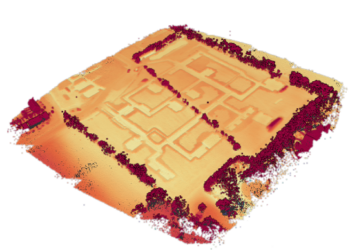Choosing the right point cloud format
In this blog post, we’re diving deep into point cloud formats. Ever wondered which format suits your needs best? Or perhaps you think it’s not a big deal? We’re here to tell you why choosing consciously matters.
The format you pick can impact your work, be it in surveying, construction or data analysis. It affects efficiency, costs, compatibility, and how future-ready your projects are. We’ll simplify the options and provide personalized advice on the best point cloud formats for your goals. Join us on this journey and learn how to make a smart choice.
Let’s begin with a brief overview at the most common point cloud formats.
- E57: An open standard format supporting 3D points, images, scans, and other metadata. It’s extensible and customizable.
- LAS: A common open standard point cloud format, especially used in LiDAR applications.
- LAZ: A highly compressed version of LAS, conserving space while preseving all data.
- PLY: A format for 3D polygons or meshes, vendor-neutral in design.
- PCD: A format supported by the open-source Point Cloud Library.
- XYZ: An ASCII format containing only point positions.
- PTS: An ASCII format containing positions, intensities and color.
- PTX: An ASCII extended version of PTS including scan and registration data.
- CL3: A binary format generated by Topcon scanners.
- POD: A point cloud format supported by Bentley Systems.
- RCP: A point cloud format linked to Autodesk Recap.
- FLS: A proprietary format by Faro, used in Faro Scene.
- …
The list extends beyond these popular formats, offering a wide array of options to suit various needs and applications.

Binary vs ASCII
To make a good choice, it’s essential to understand the contrast between binary and ASCII formats. ASCII files consist of plain text, making them readable and editable by humans. On the other hand, binary files comprise machine-understandable bytes, not directly interpretable by (normal) people.
While ASCII files can be opened in a standard notepad application in theory, that will be challenging for very large point clouds due to the file size. Binary files are more compact and will be more efficient for computer programs to process.
Our advise: use binary!

Vendor Neutrality
It is important to choose a format that is widely adopted by the industry. This ensures smooth interaction between different software applications, hardware systems and platforms. Data exchange will be easy without the need for specialized converters or custom solutions.
Open standards are not controlled by a specific vendor or company. They are maintained and updated by a community or a consortium. That encourages contineous developments and adaptation to future technologies. This guarantees the format’s usability in the long run. Avoiding proprietary, closed formats reduces dependency on a specific vendor or technology. It is your best protection against data loss.
Our advise: check your import and export options – go with an open standard if you can!

Size matters
Point clouds can be extremely large, especially in high-resolution scans or wide areas. Compression reduces the size of the data so the associated storage cost will decrease. Smaller point clouds can be transferred more quickly over networks. That is particulary important when sharing point clouds with other stakeholders.
As less data needs to be read from storage, visualisation and analysis software will load compressed data faster. This will enhance the overall user experience.
Our advise: opt for a well-compressed, binary format. In case of doubt, compare file sizes of different formats!
In the context of point clouds, the importance of choosing the right format cannot be overstated. The optimal choice should seamlessly fit into your unique situation. Maybe your choice is limited because of the software solutions and hardware ecosystem your projects are built upon.
Nevertheless, when you have freedom of choice, our recommendation is very clear. Lean towards a binary, well-compressed open-format. Efficient data storage and interopability will be guaranteed. Your point clouds will remain accessible, manageable and ready for the challenges of tomorrow.
In particular, E57, LAS, or LAZ are excellent format choices, with LAZ particularly standing out for its compactness. If you require additional support for images or scan data, E57 is a good bet.
We hope that this article will help you to make the right choice. Good luck!
Ready to move your point clouds to the cloud?
Sign up for our trial and discover the power of our platform!
Try now Product tourRelated articles

LiDAR: How the use of laser pulses can lead to accurate landscape analysis
When I ask you to think about laser pulse technology, you’ll probably envision some big satellite or space station. But what if I tell you that nowadays, you can even find a laser scanner in your Iphone!
In this article we’ll tell you all about LiDAR, and why you probably should be using it.

